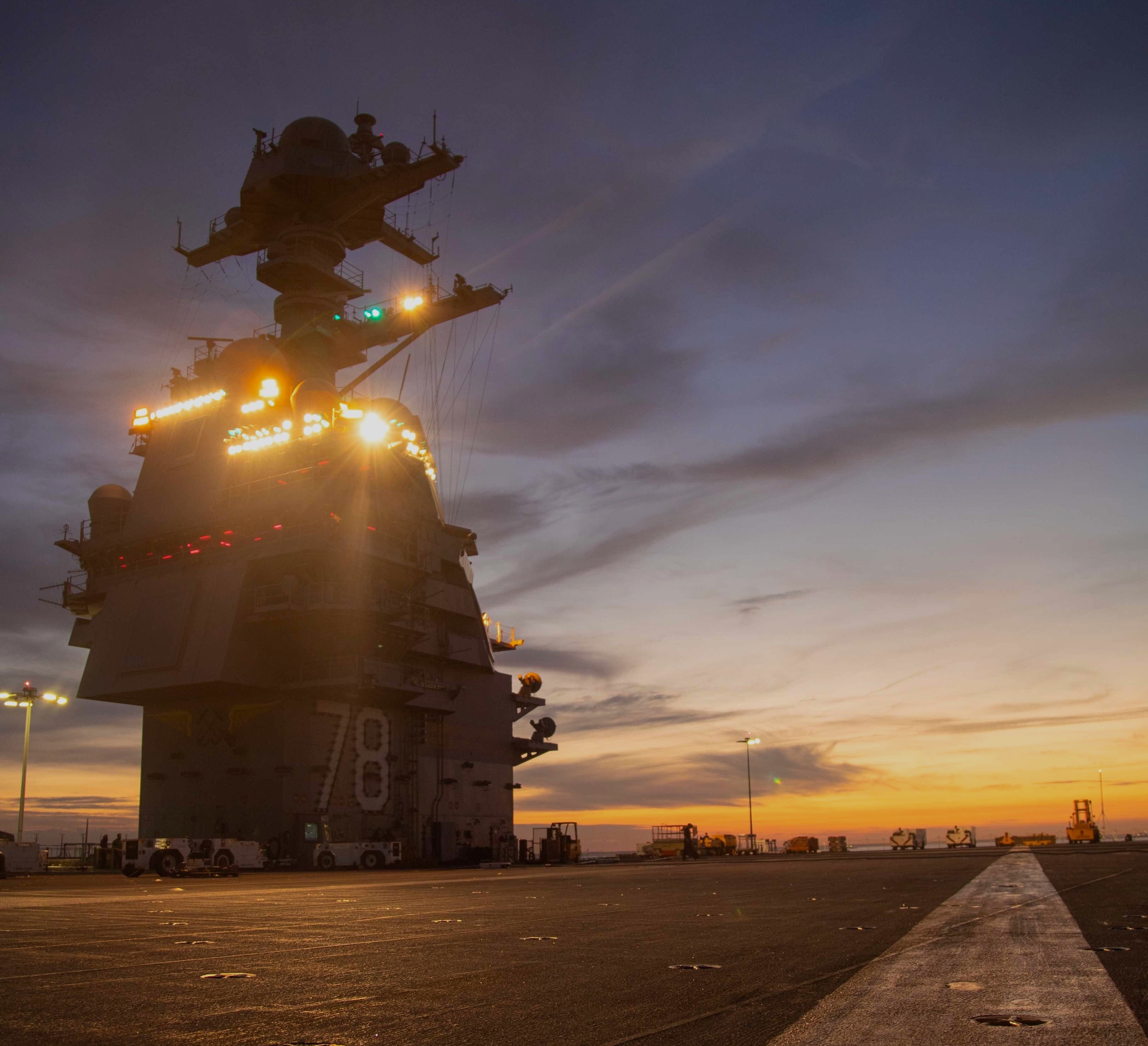
ABOARD AIRCRAFT CARRIER USS GERALD R. FORD – USS Gerald R. Ford (CVN-78) has been in and out of port for more than a year as the Navy continues to wring out the bugs from the new technologies on the next-generation carrier. While progress is steady, the program still has several milestones to achieve before it’s ready for its inaugural deployment.
Ford is slated to finish its post-delivery test and trials period and certify all of its weapons elevators, which have caused delays to the ship’s schedule, before starting full-ship shock trials in May.
During a USNI News trip last week aboard Ford, crew members were optimistic about the possibilities the first-in-class carrier holds for the Navy’s future and the progress the crew has made in recent at-sea periods. But with a few more months to go in the testing stage, the crew is still working to increase the reliability of multiple new technologies aboard the ship.
The Navy hopes that the numerous changes made on Ford – meant to make the carrier more efficient and lethal compared to the Nimitz class, with less manning and a higher sortie-generation rate – will help the ship evolve for different warfighting missions throughout its service life.
After facing criticism from lawmakers in both parties over delays to the lead ship, officials say Ford’s time at sea over the last year has allowed sailors to experiment with the new systems – like the Advanced Weapons Elevators, Advanced Arresting Gear (AAG), and Electromagnetic Aircraft Launch System (EMALS) – while also beginning to practice strike group operations.
“These are enormous undertakings. There’s been some problems. There’s been some cost issues. Most of that’s history,” Rear Adm. James Downey, the Navy’s program executive officer for aircraft carriers, told reporters aboard Ford last week.
This PDT&T phase allows Ford Commanding Officer Capt. J.J. Cummings to achieve the carrier’s required certifications, while Carrier Strike Group 12 Commander Rear Adm. Craig Clapperton can work on command and control operations and shipyards workers can finish the weapons elevators, Downey said. He noted that 10 to 15 percent of maintenance work scheduled for later on has been moved up.
Systems and Metrics
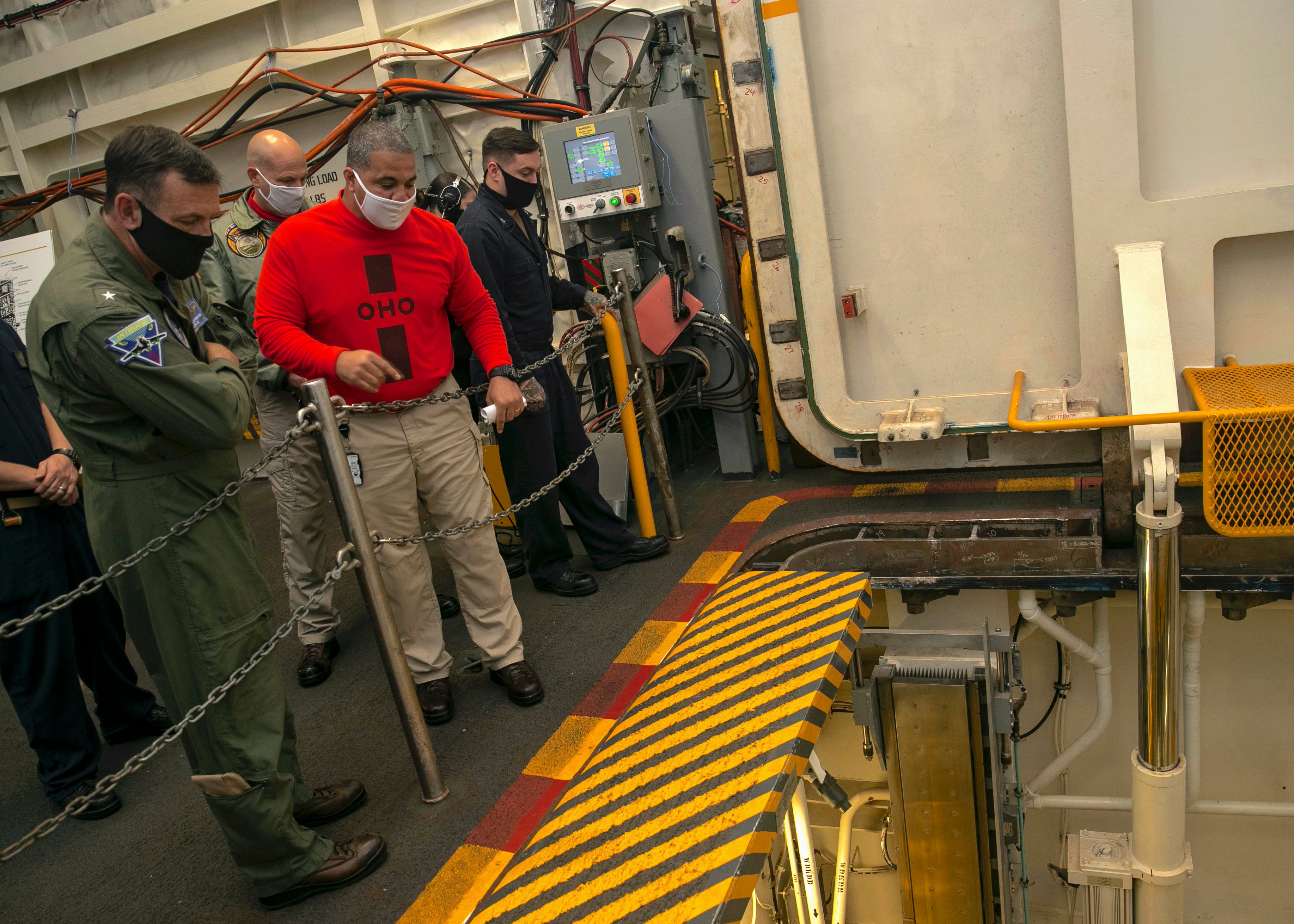
Ford is more than halfway through this post-delivery test and trials stage – an 18-month period where the carrier spends about half the time at sea and half in port – which should wrap up in April. In addition to the shipyard crew finishing up construction on the elevators and conducting some work originally scheduled to take place next year, Ford‘s crew has also spent time at sea working with an air wing and even starting to work with a carrier strike group staff, so the crew can learn not just how to use Ford‘s new technologies but how to use them while conducting relevant missions.
As it uses the new systems aboard the carrier, the crew is for the first time performing continuous cyclic flight operations.
While the carrier does not have a full air wing onboard yet, Clapperton said the crew has already become proficient enough to recover an aircraft every 55 second during cyclic operations on the flight deck.
Clapperton said “we have about two-thirds of an air wing onboard versus an entire air wing, and we’re running about the same number, about two-thirds of the sorties, that a Nimitz-class aircraft carrier would run when she’s in her full work-ups,” meaning the Ford crew is already operating at about the same efficiency that a Nimitz-class carrier would be during its basic phase training. During recent at-sea operations, the carrier has had about 35 planes aiming to conduct about 50 sorties a day – and that rate will only go up as the crew gets more efficient and the full air wing comes onboard. The Ford class was actually built to conduct about 30 percent more sorties than the Nimitz class.
With a larger flight deck than the Nimitz class and its tower moved closer to the stern of the ship, Cummings said the flight deck layout and space will help the crew reach its goal of launching more aircraft faster.
“I’ll tell you this: being this close to the stern is great. So any ship captain is worried about their stern. So here, the stern is right here,” Cummings told reporters in Ford‘s bridge. “Because your stern swings, it gets you in trouble. I have a very clear picture of where the stern is because I’m basically sitting on it. Nimitz class, you’re further forward. You got to estimate where the stern is because the island is further forward. Here, I know exactly where my stern is. I know how it’s moving and I know how to keep myself out of trouble. That’s a nice benefit of the island being further aft.”
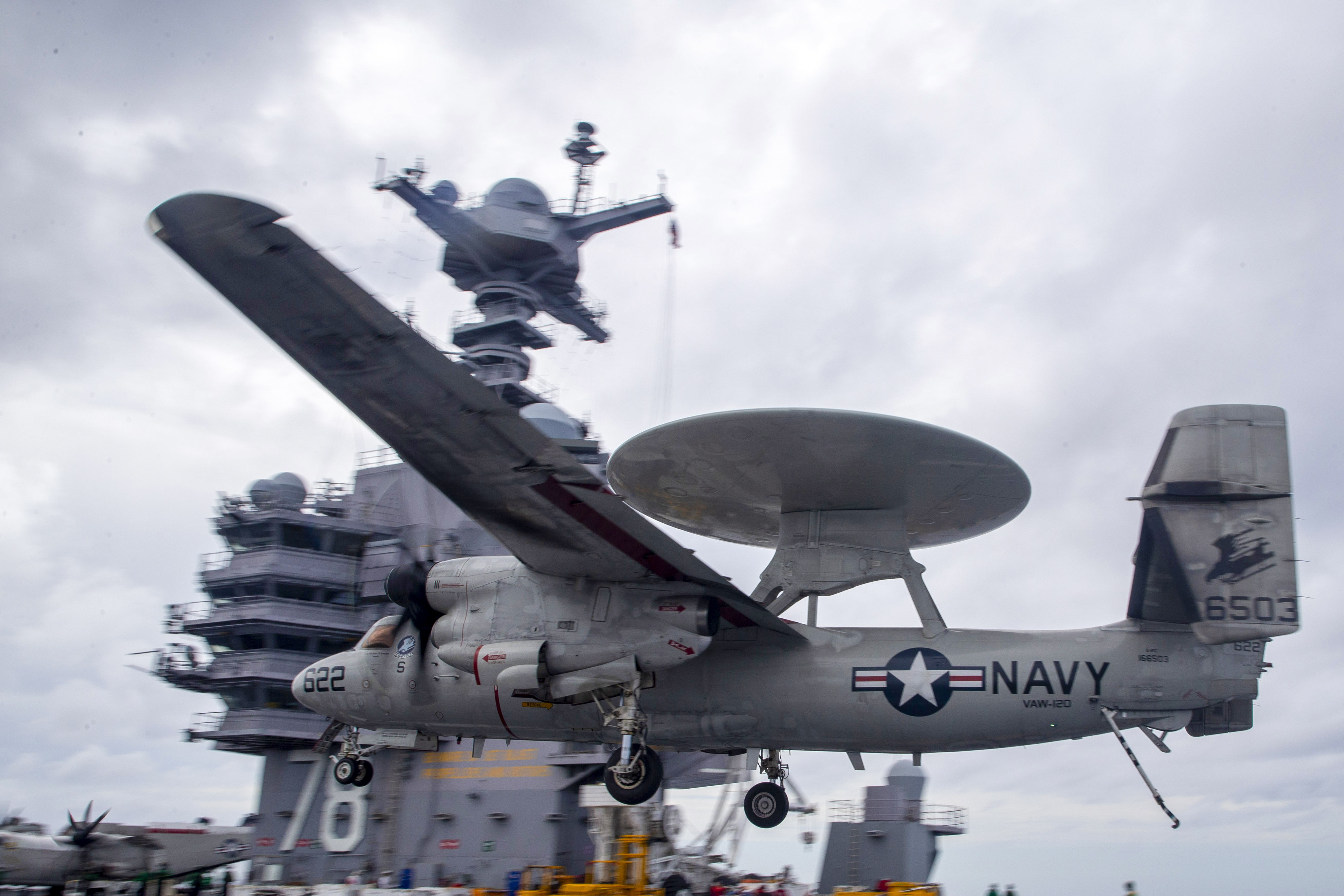
While the hull of Ford is quite similar to that of the Nimitz class, Cummings said Ford has automatic throttles in the reactor plant and only requires one sailor to operate the throttle. Nimitz-class carriers need three sailors to run the throttle, he noted.
The throttles make it so that the carrier can go from its highest speed to an emergency stop within the length of four ships.
“For a 90,000-ton ship, that’s pretty amazing,” Cummings said. “And that’s a direct result of the automatic throttles downstairs – make this thing very responsive to speed, and then stopping power . . . [is an] automatic feature of those throttles.”
Cmdr. James Howell, Ford‘s navigator, said that after driving several Nimitz-class carriers, he doesn’t observe much of a difference driving Ford.
“There’s not a whole lot different. The shadow zones are a little bit bigger,” Howell said when asked what is different about the bridge of Ford versus the Nimitz class.
“Basically if there was a small contact or a buoy or something like that, there is a blind zone just based on the angle from our eyeballs here, to the flight deck, to the waterline – there is an area where you can’t see,” he added. “Obviously being a little further aft, you know, you’re going to have a little harder of a time seeing.”
The most aircraft Ford has had aboard to date is 35 — including 25 fighters and eight rotary aircraft — during its current underway period, according to Cummings. Two days before USNI News was aboard Ford, Cummings said the crew in one minute and 47 seconds launched four aircraft using the ship’s four catapults.
Lt. Cmdr. Kyle Terwilliger, weapons systems officer with the “Black Lions” of Strike Fighter Attack Squadron (VFA) 213, said three F/A-18 Super Hornet squadrons and one E-2 Hawkeye squadron are participating in the flight operations on the carrier.
“This is the longest time the Ford has done cyclic operations. What we’ve been able to accomplish is every day for two weeks with one no-fly day, we’ve launched for six events a day – launched and recovered airplanes every single event on that time,” Terwilliger told reporters in Ford‘s ready room, a space one crew member compared to a living room because the crew spends time together there after flight operations. “So this is the beginning of really integrating an air wing and a carrier together.”
The flight operations are also allowing the crew to test technologies like EMALS and AAG and work out any software issues that may arise in the systems. Both systems are new to Ford and utilize software components to launch and recover aircraft on the flight deck. But the software aspect presents its own learning curve: Ford’s EMALS experienced a crash over the summer, prohibiting the carrier from performing flight operations for five days.
Capt. Josh Sager, the commanding officer of Carrier Air Wing 8 (CVW-8), said Nov. 17 that Ford had all three of its AAG wires operating with no issues for the preceding four to six days.
Cummings described the reliability for both the Dual Band Radar and AAG as getting better throughout every at-sea period.
“We’ve shown very good response to Dual Band Radar over the last year or so doing these sea-based developmental testings. It’s been going very well,” Cummings told USNI News on the flight deck. “We’ve done high-fast, low-fast, low and slow – all with good response from the system that showed good simulated engagement from our Shipboard Self Defense System.”
Since the carrier does not have a full air wing onboard yet, Cummings could not provide a number for the sortie-generation rate – which is meant to be 30 percent greater than the Nimitz class – but said crucial design elements like the weapons elevators and fueling stations on the flight deck are showing that Ford can perform flight operations more effectively than its predecessor.
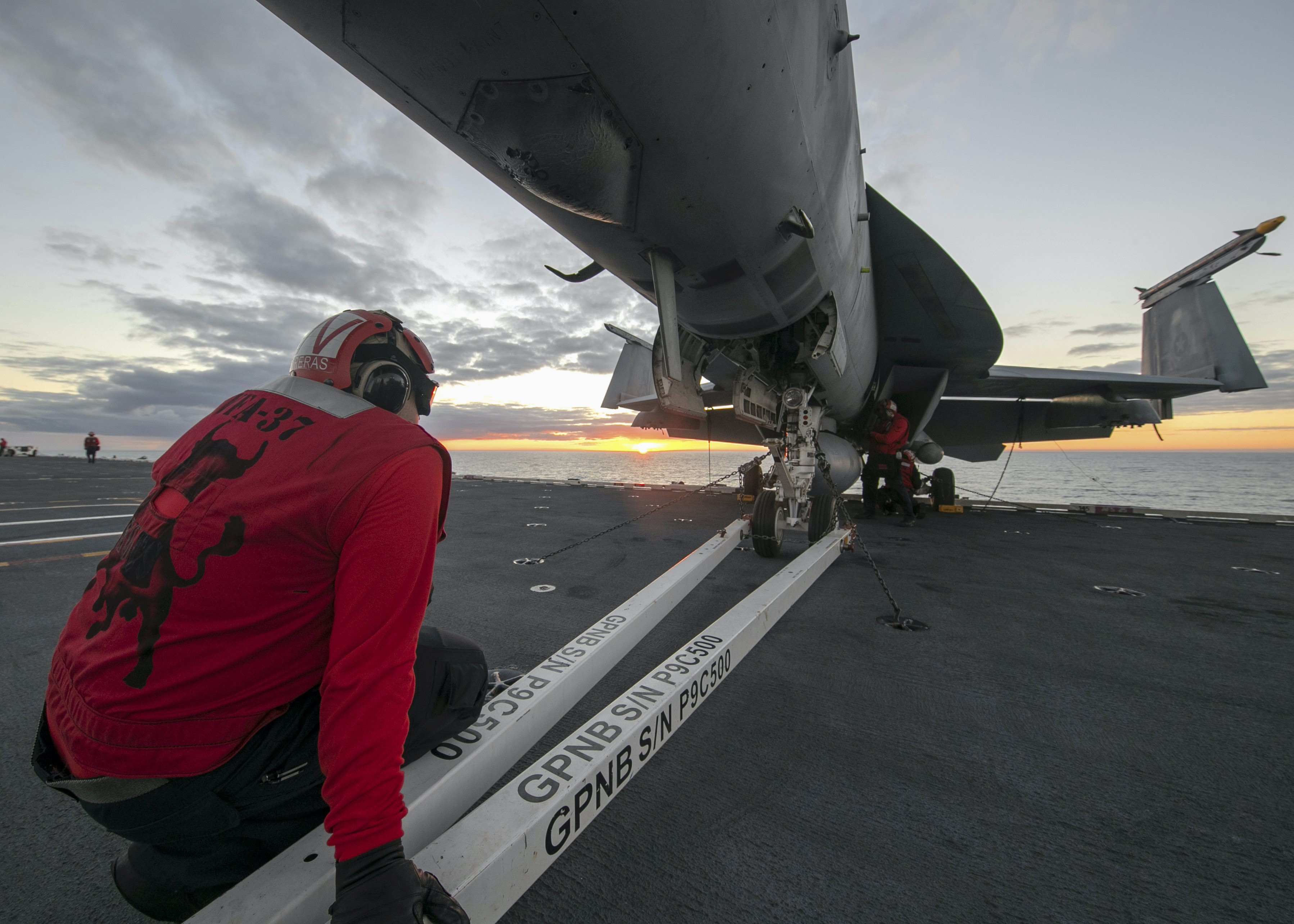
“What we know of is this: that the systems are getting better each time we get underway. We’re putting improvements to AAG and EMALS every time we get back into port and make those software changes. So we’ve not really had a chance to fully pulse the ship and the amount of sorties it can actually push off,” Cumming said. “I can tell you this though – without my description of the flight deck, of how the ease of access to the catapult, in-deck fueling stations, the location of our weapons elevators and the island being moved further aft — there’s much more real estate in that NASCAR pit row mentality as we reload and refuel aircraft that will have increased ability and adaptability and flexibility to get jet aircraft in the air much quicker.”
“But we’re seeing indications that access to the catapult, and ability to move our weapons to the flight deck much more efficiently than Nimitz class, we should see that increased efficiency and flexibility in our flight deck operations,” he added.
Since the beginning of 2020, Ford has conducted 5,000 launches and recoveries of aircraft – most of which the crew has done in the last eight months — and is slated to achieve 6,000 by the end of this calendar year, Cummings said.
Strike Group Operations
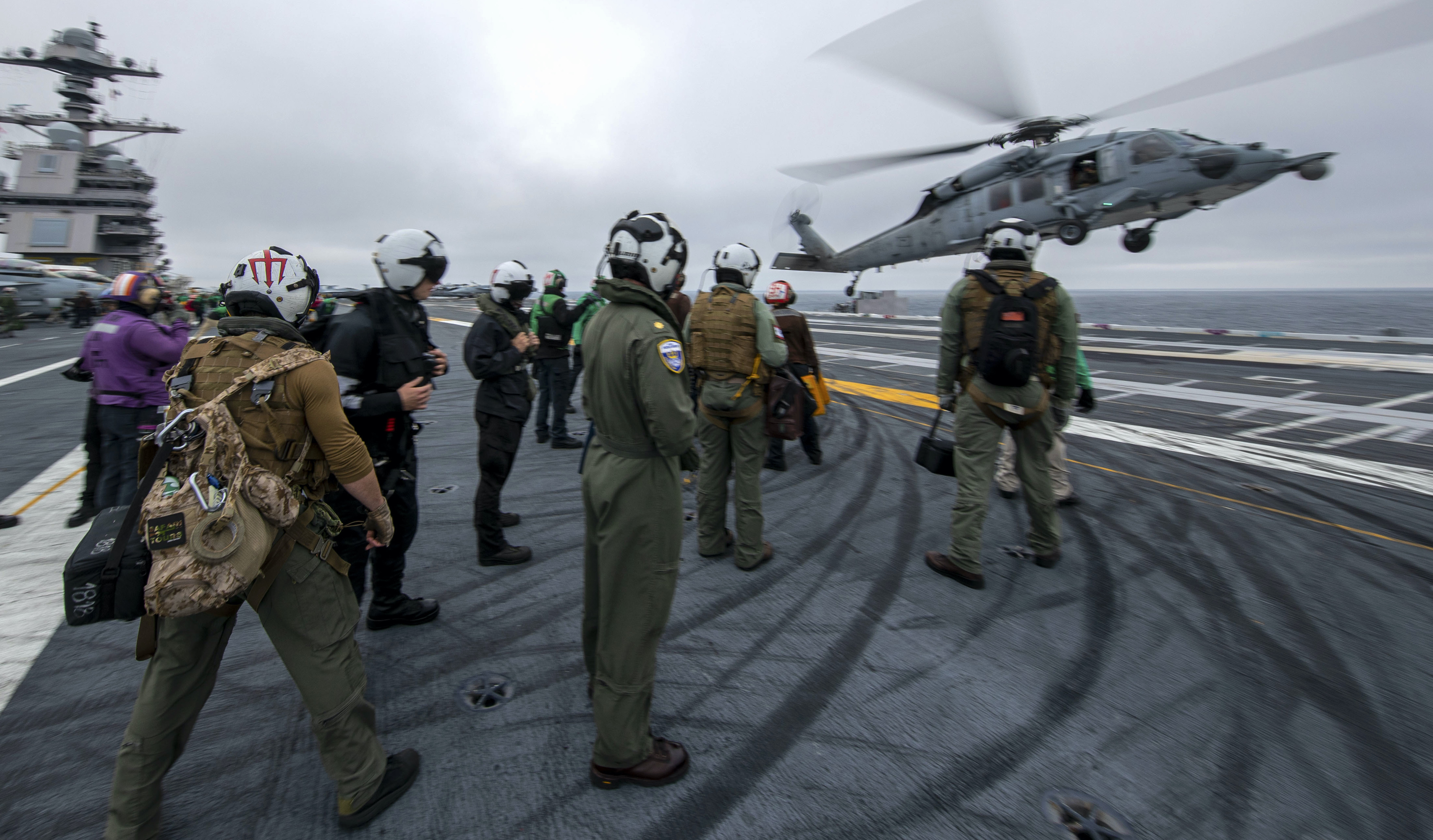
While the current testing period is largely focused on obtaining various accreditations – like Carrier Air Traffic Control Center (CATCC) Certification and Flight Deck Certification (FDC) – Navy officials have emphasized that incorporating strike group operation drills into the PDT&T phase is helping prepare the carrier for operations down the road.
During a press conference in Ford’s foc’sle, Clapperton said warfare commanders within the CSG are all currently operating aboard Ford now.
“We’ve got all four of the major warfare commanders – plus the commanding officer of the carrier and the strike group commander – all out here together. And we’ve really stepped up the level of complexity and integration for the Ford strike group. We are no longer just doing the required test in intervals for the PDT&T session. We are now doing integrated strike group operations very similar to what you would see an aircraft carrier in work-ups doing,” Clapperton said.
“And really this week – last week was a little bit more of the basic phase stuff – this week they’re starting to see a little bit of increase in complexity and full-spectrum operations: air defense exercise, maritime strike exercises, strait transit exercises, [anti] submarine warfare exercises, and combat search and rescue exercises. All that going on essentially simultaneously with this test and evaluation period for the carrier as well,” he added.
Downey said the strike group commander would not typically be onboard the ship during PDT&T and therefore his presence and the ship’s drive to start conducting these strike group operations have changed the order of events in this testing period.
While in the testing stage, the crew uniquely has the chance to experiment with potential changes to how they conduct strike group operations. For example, during USNI News’ time aboard Ford, the strike group’s air defense commander was operating in the Tactical Flag Command Center, where the CSG sits, while Ford practiced a strait transit.
Capt. Corey Keniston, the commanding officer of guided-missile cruiser USS Gettysburg (CG-64), would typically perform his duties while onboard the cruiser, not the carrier. But during this developmental testing, the crew is seeking to learn how Keniston physically operating from the carrier could affect CSG operations.
Officials acknowledge that, due to Ford’s expected 50-year service life, the mission of the carrier and its air wing is likely to evolve. Because of this possibility, Downey said the Navy factored in potential changes to the design of rooms inside the ship by making some spaces modular, so they could be reconfigured as needed.
“As you modernize a ship over its life, in these spaces about 40 percent of the cost goes to rip-out – removing ventilation, moving HVAC around, pulling welding out,” Downey told reporters in Ford’s ready room. “So we spent a lot of time analyzing that 15 to 20 years ago and said that if you make the space reconfigurable, the hot work isn’t required. You can save that money. More money can go to the actual investment in modernized equipment instead of the rip-out.”
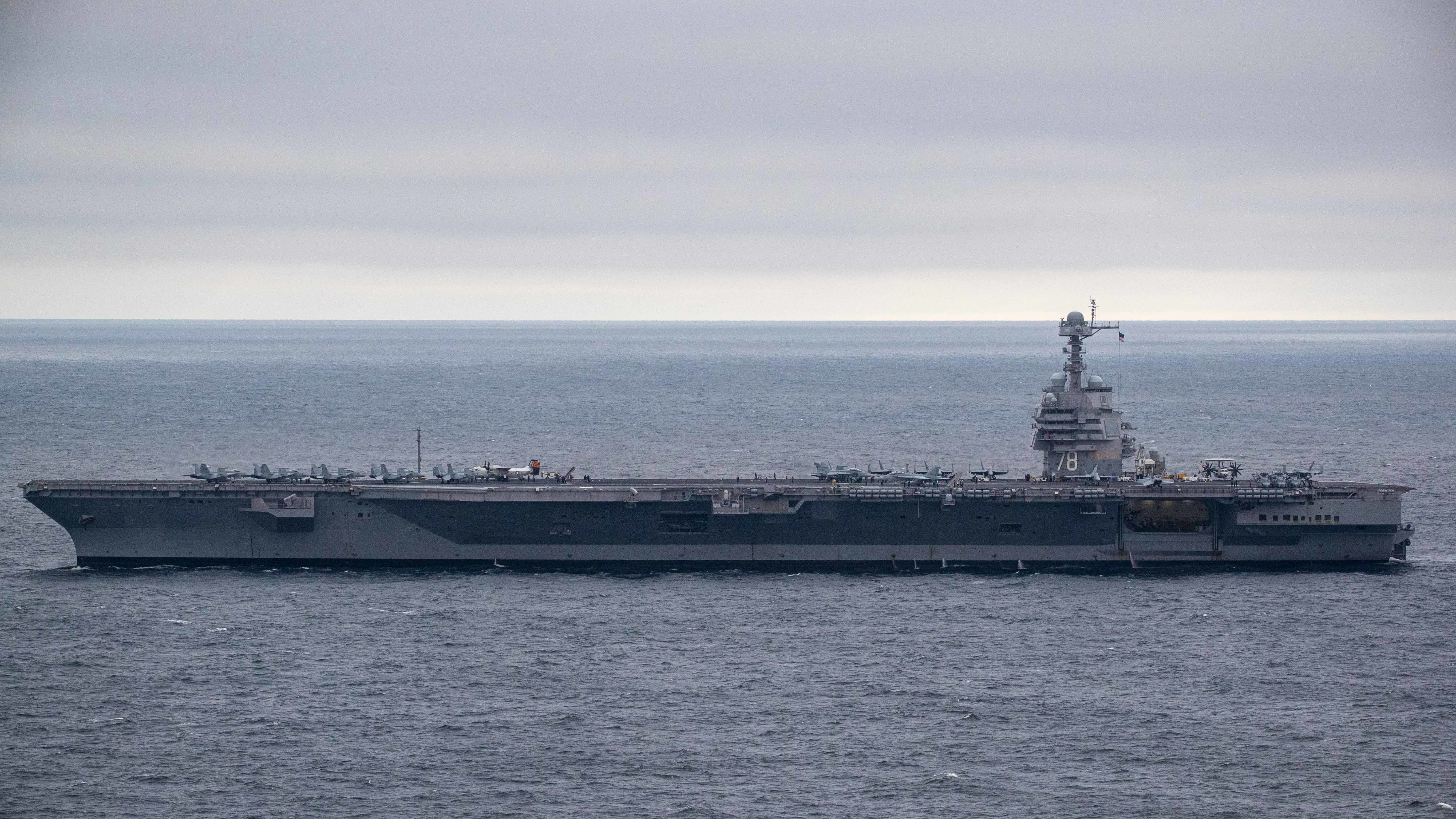
Nimitz-class carriers were not built to be modular, meaning crews cannot always easily find space on the carrier, said Capt. Mark Colombo, aircraft carrier requirements officer for Naval Air Force Atlantic. The modularity, in particular, could help the Navy as it explores what carrier aviation looks like in future conflict.
“We talk about modularity: the air wing changes,” said Colombo. “Over a 50-year lifespan, you’re going to see a brand new air wing before this ship’s retired. Its modular layout caters to that perfectly.”
Downey noted the lighting in the ready room can be moved and pointed to structures within the space that were bolted in as opposed to welded.
While the ability to reconfigure a room was a crucial part of Ford’s design, Downey said the crew needs time to see how it could further adapt the space as necessary.
“The mission in the ready room stays relatively the same – the orientation can change. But some of the command centers change significantly over time,” Downey said.
Path Ahead

With the seventh of 11 weapons elevators slated for certification before the end of this calendar year, Downey said the remaining four will be completed by the end of April 2021. Newport News Shipbuilding has 200 shipyard workers aboard the carrier to aid in finishing the elevators, which carry ordinance to the flight deck and are a crucial element of increasing the carrier’s sortie-generation rate. While the elevators on the Nimitz-class carriers operated on cables, Ford‘s new elevators use magnet motors to move through the ship.
May will be a preparation month for full-ship shock trials, Downey said, while June and July will feature live ordnance shots in the water near the ship’s hull. August is a data-collection period, and a maintenance availability will begin in September, Downey said of the planned schedule.
“Because we’re a bit ahead, we’re trying to get an early start to that availability in August versus September,” he said, laying out some ways the ship could hasten its remaining schedule and start preparing for its maiden deployment sooner. “So September plus six (months of planned maintenance), and then there’s whatever other work-ups and deployment employment preparations. That’s an issue within the Navy that we’ve got to present our readiness to those chains of command.”
Downey said he could not pinpoint an exact timeframe for Ford’s first deployment, but Commander of Naval Air Force Atlantic Rear Adm. John Meier in September said Ford is on track to deploy in 2022.
“I can’t tell you the deployment date is this or that. The issue is we’re about 15 percent ahead of our maintenance, modernization and ship completion schedule,” Downey said. “And now we’ve pulled up command and control activities. That’s where we are overall.”





